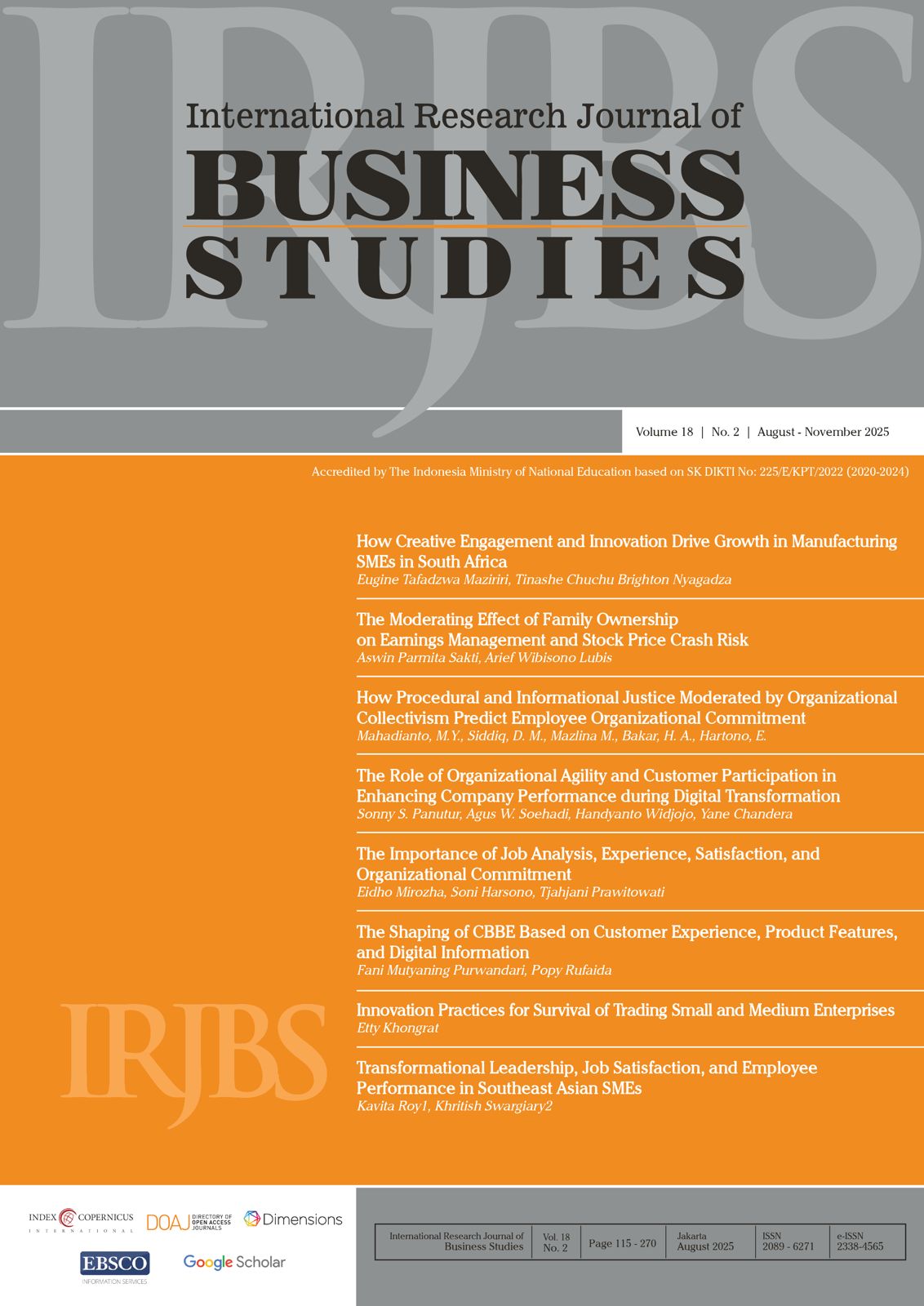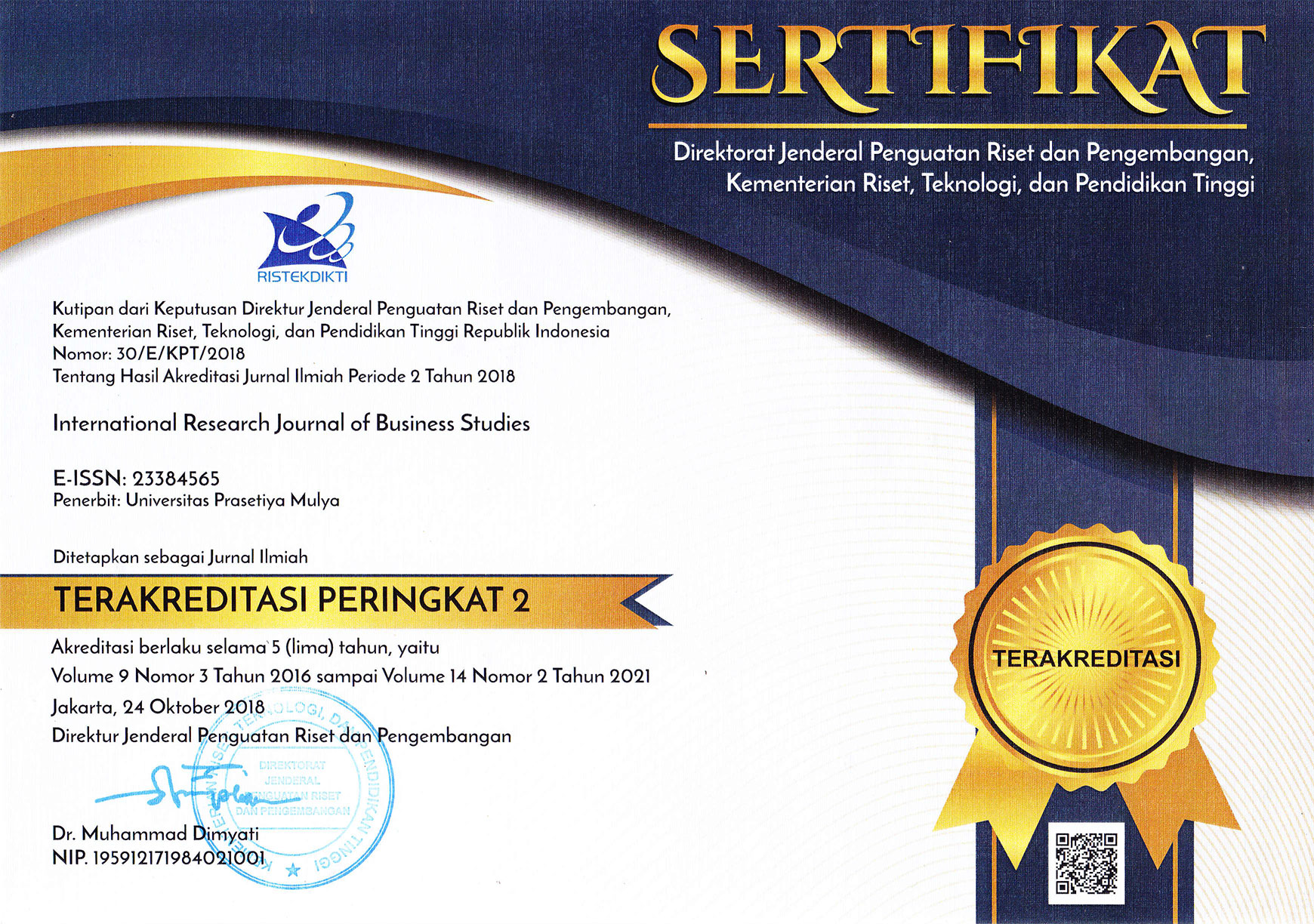The Shaping of CBBE Based on Customer Experience, Product Features, and Digital Information
DOI:
https://doi.org/10.21632/irjbs.18.2.217-235Keywords:
Customer experience , Product Features, Customer-based brand equity (CBBE)Abstract
This study originates from a question regarding what shapes brand strength in the minds of customers, particularly in the context of mortgage products (KPR) offered by bank. Customer experience, product features, and digital information are considered key interrelated factors. The study involved 100 mortgage customers of bank and employed a quantitative approach using Partial Least Squares Structural Equation Modeling (PLS-SEM). The results indicate that customer experience and product features have a strong influence on customer-based brand equity (CBBE), while digital information did not show a significant direct effect. Product features such as competitive interest rates and an easy application process were found to play a dominant role in shaping brand perception. Furthermore, customer experience influences CBBE indirectly through perceptions of product features. These findings emphasize that brand building is not solely about promotion, but also about delivering real customer experiences, offering clear product value, and implementing effective digital communication strategies.
References
Larivière, B., Schecten, L., Bogaert, M., & Van den Poel, D. (2024). Customer experiences and coping behaviors during crisis situations: The role of service adaptation and service transformation. Journal of Business Research, 163, 114089. https://doi.org/10.1016/j.jbusres.2024.115089 Whyte, J., & Eshraghi, A. (2025). Digital information in temporary organizations. Journal of Information Technology, 40(2), 0149. https://doi.org/10.1016/j.scaman.2025.101419 Çelik, B., Schwarz, J. A., & Tan, B. (2023). New product introductions with selection of unique
and common features in monopoly markets. Omega, 123, 103018. https://doi.org/10.1016/j.omega.2023.103018 Akdogan, C. B., Uray, N., Ulengin, B., & Kiygi-Calli, M. (2024). A holistic empirical approach to marketing activities and performance interaction in banking industry: The mediating role of customer-based brand equity. Business Process Management Journal, 31(2). https://www.emerald.com/insight/publication/issn/1463-7154 Lee, P.-C., & Liu, P.-J. (2025). Digital information-seeking of homebuyers on real estate platforms in Taiwan. The Electronic Library, 43(3). https://www.emerald.com/insight/publication/issn/0264-0473 Nicolaescu, L., & Tudorache, M. T. (2022). Human-computer interaction in customer service: The experience with AI chatbots—A systematic literature review. Electronics, 11(19), 1579. https://doi.org/10.3390/electronics11101579 Jiang, Z., & Lyu,J. (2024). The role of augmented reality app attributes and customer-based brand equity on consumer behavioral responses: An S-O-R framework perspective. Journal of Product & Brand Management, 33(7/8). https://www.emerald.com/insight/1061-0421.htm Sabbir, M. M. (2025). Product feature and lifespan as a quality indicator for inducing eco-friendly furniture purchase. Journal of Cleaner Production, 445, 139242. https://doi.org/10.1016/j.heliyon.2025.e42422 Díaz, O., Medeiros, R., & Al-Hajaji, M. (2024). How can feature usage be tracked across product variants? Implicit feedback in software product lines. Journal of Systems and Software, 214, 112101. https://doi.org/10.1016/j.jss.2024.112013 Zhou, Z., & Verburg, R. M. (2023). The impact of product features on market orientation in technology-based new ventures. Journal of Business Research, 163, 114230. https://doi.org/10.1016/j.jbusres.2023.114230 Park, J. R., Poole, E., & Li, J. (2022). Stylometric features in librarian’s responses to user queries: Implications for user interaction in digital information services. Journal of Documentation, 78(2). https://www.emerald.com/insight/2514-9342.htm Kukk, M., & Levenko, N. (2021). Interest rate spreads: Differentstoriesfor different types of loan. Economic Systems, 45(3), 100874. https://doi.org/10.1016/j.ribaf.2024.102524 Jiang, Z., & Lyu,J. (2024). The role of augmented reality app attributes and customer-based brand equity on consumer behavioral responses: An S-O-R framework perspective. Journal of Product & Brand Management, 33(7/8). https://www.emerald.com/insight/1061-0421.htm Sahoo, D., Soni, N., & Mishra, A. (2024). Emojis and consumer-based brand equity: Mediation role of engagement. Journal of Retailing and Consumer Services, 77, 104264. https://doi.org/10.1016/j.joitmc.2025.100574 Hair,J., & Alamer, A. (2022). Partial Least Squares Structural Equation Modeling (PLS-SEM) in second language and education research: Guidelines using an applied example. Research Methodsin Applied Linguistics, 1(3), 100027. https://doi.org/10.1016/j.rmal.2022.100027 Bonfanti, A., Bagnato, G., & Vigolo, V. (2024). The contribution of sustainable practices to the creation of memorable customer experience: Empirical evidence from Michelin Green Star restaurants. Journal of Business Research, 169, 115020. https://doi.org/10.1016/j.jbusres.2024.115020 Akın, S., & Gürbüz, E. (2024). The relationship of internet banking users’ emotional brand experiences and consumer-based brand equity. European Journal of Management Studies, 85, hL. 92. https://www.emerald.com/insight/2183-4172.htm
Downloads
Submitted
Accepted
Published
How to Cite
Issue
Section
Categories
License
Copyright (c) 2025 Fani Mutyaning Purwandari, Popy Rufaidah (Author)

This work is licensed under a Creative Commons Attribution-ShareAlike 4.0 International License.
Journal Author(s) Rights
For IRJBS to publish and disseminate research articles, we need publishing rights (transferred from the author(s) to the publisher). This is determined by a publishing agreement between the Author(s) and IRJBS. This agreement deals with the transfer or license of the copyright of publishing to IRJBS, while Authors still retain significant rights to use and share their own published articles. IRJBS supports the need for authors to share, disseminate and maximize the impact of their research and these rights, in any databases.
As a journal Author, you have rights to many uses of your article, including use by your employing institute or company. These Author rights can be exercised without the need to obtain specific permission. Authors publishing in IRJBS journals have comprehensive rights to use their works for teaching and scholarly purposes without needing to seek permission, including:
- use for classroom teaching by Author or Author's institution and presentation at a meeting or conference and distributing copies to attendees;
- use for internal training by the author's company;
- distribution to colleagues for their research use;
- use in a subsequent compilation of the author's works;
- inclusion in a thesis or dissertation;
- reuse of portions or extracts from the article in other works (with full acknowledgment of the final article);
- preparation of derivative works (other than commercial purposes) (with full acknowledgment of the final article);
- voluntary posting on open websites operated by the author or the author’s institution for scholarly purposes,
(But it should follow the open access license of Creative Common CC-by-SA License).
Authors/Readers/Third Parties can copy and redistribute the material in any medium or format, as well as remix, transform, and build upon the material for any purpose, even commercially. Still, they must give appropriate credit (the name of the creator and attribution parties (authors' detail information), a copyright notice, an open access license notice, a disclaimer notice, and a link to the material), provide a link to the license, and indicate if changes were made (Publisher indicates the modification of the material (if any) and retain an indication of previous modifications.
Authors/Readers/Third Parties can read, print and download, redistribute or republish the article (e.g. display in a repository), translate the article, download for text and data mining purposes, reuse portions or extracts from the article in other works, sell or re-use for commercial purposes, remix, transform, or build upon the material, they must distribute their contributions under the same license as the original Creative Commons Attribution-ShareAlike (CC BY-SA).
This work is licensed under a Creative Commons Attribution-ShareAlike 4.0 International License.








